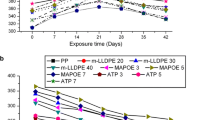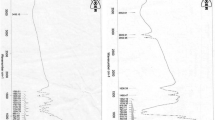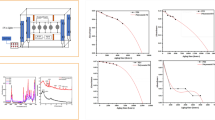Abstract
The effects of UV irradiation on chemical, thermal, mechanical, and morphological properties of polyvinyl alcohol (PVOH)/2 wt.% of nanoclay(NC) filler were investigated. PVOH composite films were prepared from PVOH blend with fixed content (2%) of NC via the solution casting method. Pure PVOH and PVOH composites were exposed to 340 nm fluorescent UV lamps and assessed for 50 h, 100 h, and 200 h UV exposue. The experimental results such as Fourier transform infrared (FTIR) confirmed that 2% wt. NC filler is efficient and can resist chemical degradation that is caused by ultraviolet irradiation (UV). The carbonyl and hydroxyl indices were increased with increasing the UV exposure irradiation times of both PVOH and PVOH composite. However, the PVOH nanocomposites exhibited more resistant to increasing the indices after exposure to UV irradiation with a longer exposure time. The thermal results (TGA) indicated that PVOH nanocomposite is exhibited more resistance to thermal degradation after UV irradiation exposure compared to that of pure PVOH sample. From DMA results, the storage of modulus was reduced after exposure to UV irradiation of PVOH and PVOH nanocomposites. The results of Tg of PVOH nanocomposites increased after the incorporation of 2% wt. NC into PVOH after exposure to UV irradiation. PVOH nanocomposite exhibited more resistance to reduce the tensile strength after exposure to 200 h UV irradiation. XRD tests showed that PVOH/2 wt.% NC nanocomposites have more resistant to increase intensity after exposure to 200 h UV irradiation compared to that of PVOH sample. The morphology micrographs showed that no obvious cracks on the PVOH nanocomposite after UV irradiation exposure by comparing to that of pure PVOH.















Similar content being viewed by others
References
Imam S, Cinelli P, Gordon S, Chiellini E (2010) Characterization of biodegradable composite films prepared from blends of poly (vinyl alcohol), cornstarch, and lignocellulosic fibre. J Polym Environ 13:47–55
Ye B, Li Y, Chen Z, Wu Q-Y, Wang W-L, Wang T et al (2017) Degradation of polyvinyl alcohol (PVA) by UV/chlorine oxidation: radical roles, influencing factors, and degradation pathway. Water Res 124:381–387
Sirousazar M, Kokabi M, Hassan Z, Bahramian A (2011) Dehydration kinetics of polyvinyl alcohol nanocomposite hydrogels containing Na-montmorillonite nanoclay. Scientia Iranica 18:780–784
Sothornvit R, Rhim J-W, Hong S-I (2009) Effect of nano-clay type on the physical and antimicrobial properties of whey protein isolate/clay composite films. J Food Eng 91:468–473
Mondal D, Mollick MMR, Bhowmick B, Maity D, Bain MK, Rana D et al (2013) Effect of poly (vinyl pyrrolidone) on the morphology and physical properties of poly (vinyl alcohol)/sodium montmorillonite nanocomposite films. Prog Nat Sci 23:579–587
Nawapat D, Thawien W (2013) Effect of UV-treatment on the properties of biodegradable rice starch films. Int Food Res J 20(3):1313
Niu Y, Zhang X, He X, Zhao J, Zhang W, Lu C (2015) Effective dispersion and crosslinking in PVA/cellulose fibre biocomposites via solid-state mechanochemistry. Int J Bio Macromol 72:855–861
Sonker AK, Wagner HD, Bajpai R, Tenne R, Sui X (2016) Effects of tungsten disulphide nanotubes and glutaric acid on the thermal and mechanical properties of polyvinyl alcohol. Compos Sci Technol 127:47–53
Awad SA, Khalaf EM (2018) Evaluation of the photostabilizing efficiency of polyvinyl alcohol–zinc chloride composites. J Thermoplast Compos Mater. https://doi.org/10.1177/0892705718804585
Ooi ZX, Chan KL, Ewe CY, Muniyadi M, Teoh YP, Ismail H (2017) Evaluation of water affinity and soil burial degradation of thermoplastic film derived from oil palm ash-filled polyvinyl alcohol. BioResources 12:4111–4122
Yang Z, Xu D, Liu J, Liu J, Li L, Zhang L et al (2015) Fabrication and characterization of poly(vinyl alcohol)/carbon nanotube melt-spinning composites fibre. Prog Nat Sci 25:437–444
Awad SA, Khalaf EM (2017) Improvement chemical, thermal, and mechanical properties of polypropylene by using corn flour. Usak Univ J Mater Sci 6:15–25
Khalaf E, Awad S (2016) Improvement of chemical and thermal properties of polyethylene terephthalate (PET) by using multi-walled carbon nanotubes (MWCNTs). Int J Mater Sci Appl 5:297–301
Awad S, Khalaf E (2017) Improvement, the performance of polyurethane (PUR), Y-290 resin as coating of oil pipeline by using multi-walled carbon nanotubes (MWCNTs). Eng Tech J 35:845–848
Gaume J, Rivaton A, Thérias S, Gardette J-L (2012) Influence of nanoclays on the photochemical behaviour of poly (vinyl alcohol). Polym Degrad Stab 97:488–495
Khalaf E, Awad S (2017) Improvement of mechanical and water absorbance properties of low-density polyethylene (LDPE) by using white kaolin powder (WK). J Adv Chem Sci 3:426–427
Šutka A, Järvekülg M, Šutka A, Heinmaa I, Mäeorg U, Smits K et al (2016) Mechanical reinforcement of electrospun poly (vinyl alcohol) by α-FeOOH nanowires. Polym Compos 39:2461–2468
Noori S, Kokabi M, Hassan Z (2015) Nanoclay enhanced the mechanical properties of poly (vinyl alcohol)/chitosan/montmorillonite nanocomposite hydrogel as wound dressing. Procedia Mater Sci 11:152–160
Gaume J, Taviot-Gueho C, Cros S, Rivaton A, Therias S, Gardette J-L (2012) Optimization of PVA clay nanocomposite for ultra-barrier multilayer encapsulation of organic solar cells. Sol Energy Mater Sol Cells 99:240–249
Choo K, Ching YC, Chuah CH, Julai S, Liou N-S (2016) Preparation and characterisation of polyvinyl alcohol-chitosan composite films reinforced with cellulose nanofiber. Materials 9(8):644
Khaokhajorn P, Samipak S, Nithithanasilp S, Tanticharoen M, Amnuaykanjanasin A (2015) Production and secretion of naphthoquinones is mediated by the MFS transporter MFS1 in the entomopathogenic fungus Ophiocordyceps sp. BCC1869. World J Microbiol Biotechnol 31(10):1543–1554
Follain N, Joly C, Dole P, Bliard C (2005) Properties of starch based blends. Part 2. Influence of poly vinyl alcohol addition and photocrosslinking on starch based materials mechanical properties. Carbohydr Polym 60(2):185–192
Awad SA, Khalaf EM (2018) Improvement of the chemical, thermal, mechanical and morphological properties of polyethylene terephthalate–graphene particle composites. Bull Mater Sci 41:67
Tang X, Alavi S (2011) Recent advances in starch, polyvinyl alcohol based polymer blends, nanocomposites and their biodegradability. Carbohydr Polym 85:7–16
Mousazadeh S, Shakouri A, Hojjat M, Etemad SG, Heris SZ (2016) Rheological behaviour of starch–poly (vinyl alcohol)–TiO2 nanofluids and their main and interactive effects. J Appl Polym Sci 133:140
Zhu Z (2003) Starch mono-phosphorylation for enhancing the stability of starch/PVA blend pastes for warp sizing. Carbohydr Polym 54:115–118
He P, Bai S, Wang Q (2016) Structure and performance of poly (vinyl alcohol)/wood powder composite prepared by thermal processing and solid state shear milling technology. Compos B 99:373–380
Author information
Authors and Affiliations
Corresponding author
Additional information
Publisher's Note
Springer Nature remains neutral with regard to jurisdictional claims in published maps and institutional affiliations.
Rights and permissions
About this article
Cite this article
Awad, S.A., Khalaf, E.M. Investigation of Photodegradation Preventing of Polyvinyl Alcohol/Nanoclay Composites. J Polym Environ 27, 1908–1917 (2019). https://doi.org/10.1007/s10924-019-01470-7
Published:
Issue Date:
DOI: https://doi.org/10.1007/s10924-019-01470-7




